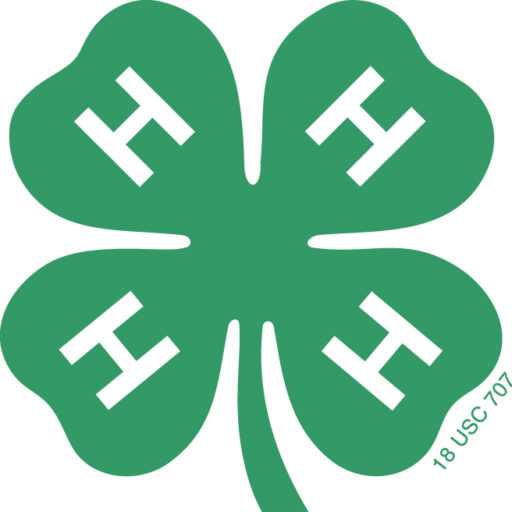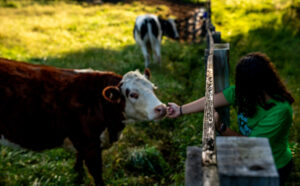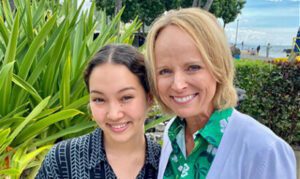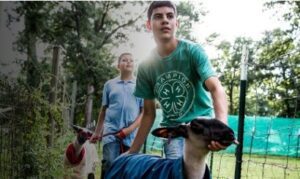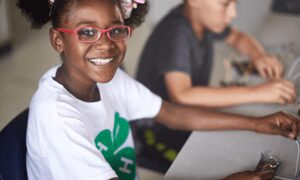Our world needs to solve big challenges in human health, agriculture, and food, and 4‑H is playing a critical role by cultivating the next generation of leaders in the agriculture industry. After the National 4‑H Youth Summit on Agri-Science this past March, teams of youth took part in the Dolphin Tank.
The Dolphin Tank”—a take on television’s Shark Tank—challenges teams of youth to develop Community Action Plans (CAP) that address a local agriculture issue in their community. The 4‑H-developed challenge provides experiences that lead to Positive Youth Development (PYD)* and sparks curiosity and discovery.
Teams were tasked with developing a written plan then pitching their ideas to ag industry leaders from Brightmark, CME Group, Farm Credit, National Corn Growers Association, Nationwide, New Holland, and Nutrien.
The highest ranked teams pitched their ideas for the opportunity to receive funds to put their plan into action. With support from Nationwide, Nutrien, and Brightmark, 24 teams from 17 states each received $1,000 to $2,000 to implement their Community Action Plan.
One of this year’s Dolphin Tank winning teams was the Eclectic Clovers Club, from Oregon State University Extension 4‑H. We got a chance to talk to Riley, a member of the team and a rising Junior at Zena Springs School in Polk County, Oregon, and Anne M. Walton, the team’s 4‑H leader, about their experience.

Riley and Anne, what inspired you to take part in the National 4‑H Summit on Agri-Science?
Riley: I have been interested in agriculture science since I was in elementary school, starting with dog training and an interest in vet school. After taking Junior Master Gardener classes I am now more focused on farm and forest. I was intrigued by the aspect of growing things that could benefit others, [like] a community garden or seed planning. In college, I want to get an engineering major and a military science minor. After college, I plan to specialize in biotechnology. Starting this project was really the opportunity to get my foot in the door and network with other people.
Anne: As a long time 4‑H Leader and Educator, I am always excited when 4‑H provides an avenue for young people to expand their knowledge and excitement about real world topics and careers.
Regarding your Summit experience, did you learn anything that surprised you?
Riley: I added to my existing knowledge of drone use in agriculture! I did not know how technologically advanced some of the drones could be for crops. This information from the speaker at Nutrien helped me develop my “Dolphin Tank” pitch. Some of the newest drones can sense temperature fluctuations in different areas of crop fields, find and herd livestock, and ensure safety of workers in the field. Prior to starting this project, I did not know very much [about] aerospace technology and its use in farming.
Anne: For Riley, it was a great [opportunity] to attend the Summit and feel she wanted to try for a CAP Award. When she brought the idea to our survey group, the students got excited about the prospect of some support for advanced equipment to use in the project, and to be part of a national award interview.
What was it like working with your team for this program?

Riley: For most of my group it was their first time doing a big presentation. We started by developing a list of what we wanted to cover in the proposal, then we got to work assigning people to topics based on what they were interested in. Once we got the script set in stone and the slides made, we practiced several times over Zoom. The whole process took about a month.
Anne: Part of our project survey area is managed by a private hardwood forest sawmill group from Willamette University and Oregon State University, so we had [several] scientists and foresters that we were already working with to bounce this award idea off of. My team members are great young people that I have already done projects with. We had been using a number of these survey techniques, learning the flora and fauna, and monitoring water levels and health on our own project grounds (my farm) for a couple years. So I felt they were ready to use these skills on a bigger scale and be able to give useful information to the neighboring properties.
What did you learn by preparing for and participating in the ‘Dolphin Tank’?
Riley: I learned how to present large-scale information and data in the form of a proposal. I thought the presentation experience was very streamlined. I appreciated the feedback we received after we presented to the panel. For my team and I, seeing the panel of adults genuinely interested was very welcomed because it is never easy for youth to get adults to notice and pay attention to our ideas and concerns about our planet.Anne: When one decides to pursue an award like this, one does so with the intention of succeeding. I told Riley and the team that they made a great effort in their essay and interview, and that alone was a great learning experience. We really could not believe how exciting it was to win. We thank you so much for this tremendous opportunity!
*Positive Youth Development (PYD) is the cornerstone of the 4‑H model. PYD:
- productively and constructively engages youth within their communities;
- recognizes, utilizes, and enhances their strengths; and
- promotes positive outcomes for them by providing opportunities, fostering positive relationships, and providing the support needed to build on their leadership strengths.






